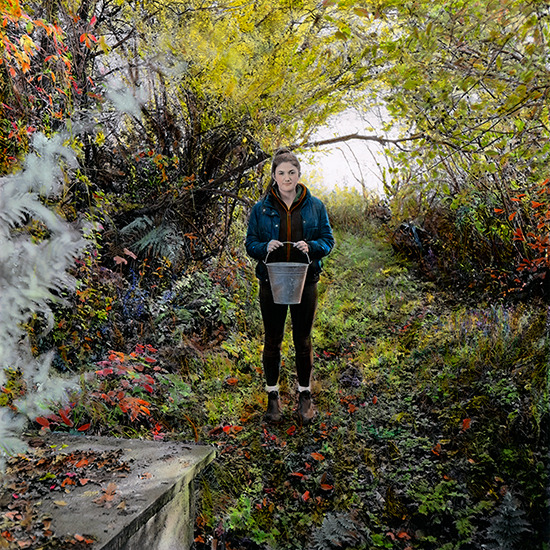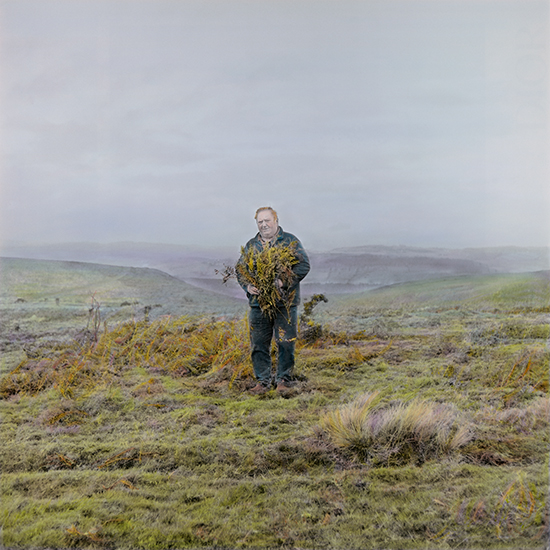| SIMON DENISON IMAGE & TEXT |
| PREVIOUS | NEXT |
ENCLOSURE Leah Gordon
Grace Layton, an agriculture student, stands near Travelly Well near the English–Welsh border in Shropshire in Leah Gordon’s photograph holding a bucket of water she has taken from the well. Roy Griffiths, a farmer, stands on the heights of Stapeley Common holding a clump of bracken he has collected as bedding for livestock on his small farm nearby. Both are exercising their commoner’s rights to act as they do. It takes a moment to remember how unusual it is now to be able to make productive use of land that we don’t strictly speaking own: to plant it, graze it, forage from it, even access it. It was not always so. People with commoner’s rights – acquired normally today by owning property close to common land – possess rights that were once widely shared by rural populations, when common land was far more widespread. In this body of work, Gordon, working with writer Annabel Edwards, has explored some of the ways in which today’s commoners use their rights and defend them. Beginning in Shropshire, the project plans to extend further afield. The story of the loss of common land through privatisation and enclosure has traditionally been told within a narrative of progress. Rational organisation of land into coherent plots, investment in drainage and soil improvement, development of farming techniques aimed at increasing productivity, all played their significant role in the construction of the modern world. But there was always another story. As Shropshire historian Paul Stamper has written, enclosure of common land was ‘generally beneficial’ but also led to the loss of common grazing, a change that was ‘particularly damaging to the smallholders and cottagers without closes to put their animals in’. Stamper believes most tenants in Shropshire were treated fairly, often receiving small plots in lieu of common rights. But it seems likely that many rural people lost the right to use land they had previously enjoyed. And the long, if indirect, historical legacy is that most people in the national population today have limited rights to access or make use of rural land. It is the story of dispossession that Gordon is particularly interested in. The photographs of current commoners are, for her, a ‘kind of snapshot of the past’, a way of drawing attention to what has been lost, and to what she regards as a historic act of theft suffered by the rural poor, and one which is too often overlooked. I myself might have been one of Gordon’s subjects, as I too hold common rights in Shropshire. When we moved from London in the mid-90s to a former farmhouse on the edge of Clee Liberty on Brown Clee Hill near Ludlow, it seemed quaint, almost comical, to find that we had acquired the right to run 64 sheep and three cattle on the hill. Like most of our fellow commoners, we have never used these rights, as we are not livestock farmers. The common is grazed by two or three local professional farmers who own large flocks, while access is free to all, not just to commoners – an arrangement that seems to suit everybody. And we certainly ‘use’ the common for access. Several times a week I lift the latch on our garden gate and stride out onto the hill, enjoying the familiar press of boot on turf, the scent of bracken in the air, the rising song of heathland birds, the long vistas over the Corvedale. For the past year we have been joined by a population of red kites, and we gaze at them, enthralled, as they wheel silently above, sometimes only a dozen or so yards over our heads. During lockdown, the common has been a godsend. Any attempt to enclose it now, or any part of it, would be regarded by local people as an outrage. As Gordon’s photographs and captions indicate, the threat of rights being lost through encroachment or neglect persists. An irony of Gordon’s work is that most holders of common rights today are the relatively well-off, as rights are linked to property. Equally, as modern farming becomes more economically viable at a larger scale, there are increasingly few smallholders in my area trying to make a living on only a few acres. Many have minimal or no grazing rights on the common. Larger political questions, then, around imbalances of access to land, and the more general national alienation from land, are brought to mind by Gordon’s work, like a low-level anxiety, or a dull ache you suddenly become aware of throbbing under the skin. Gordon’s hand-colouring of black and white originals is intended to have a defamiliarising effect, to induce in viewers a ‘more magical, less mercantile’ perception of rural land. Many people will understand that intensely affective connection we can have when we actively engage with the natural world, which seems to run deeper than cultural ideas such as the myth of the rural idyll. It is hard to put one’s finger exactly on what the connection is, or how it comes about – a matter of intense awareness, perhaps, of our surroundings, with an alertness of every sense of the body; and of tending, maybe, as much as of using. I feel it most powerfully as I work in my vegetable patch, like many gardeners, kneeling to the work before the dark composty soil. Gordon’s utopian vision is of a structural shift in society and consciousness that might allow such experiences of nature and land to become more universally available.
Ref: Paul Stamper, 1989. The Farmer Feeds Us All. Shrewsbury: Shropshire Books |
 |
|---|---|
 |
|